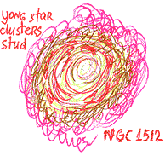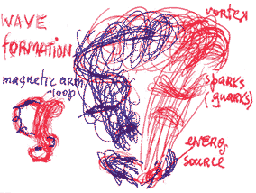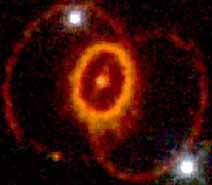Back to main Sexual Reproduction Page
All forms of reproduction are heavily influenced by their particular organisms’ dimensions and characteristics, and all stable entities are aligned as wave formations. Therefore, before we begin to discuss reproduction, a short summary of the properties of the wave formation is in order. The wave formation is comprised of two incomplete, energetic swirls (or “loops”) that are connected by an energetic path. In fact, a stable formation can only exist within a closed configuration that is comprised of two perpendicular swirls (or semi-loops), which are in, what Schrôdinger referred to as, a constant state of “superposition.” This is true of both the smallest and largest formations.



Energetic matter is endowed with peculiar revolving and rotating motions. Each swirl contains the same energetic matter, but the particular energetic matter in each swirl is aligned and behaves differently. In fact, the diverse array of energetic matter’s rotating and revolving motions is exclusively responsible for the distinctions between the two loops of the wave formation.
My earliest model of the wave formation |



One loop is electric-energetic with male characteristics and faces outward.
It tends to be more nomadic and promiscuous, initiating contact with everything
in its vicinity snatching up as much space as possible. In contrast, the
second loop has more magnetic-gravitational and female-oriented p roperties.
It faces towards the inside of the formation and has a considerably longer
life span than the energetic loop. Accordingly, the “female”
loop (adjacent picture) is charged with the storage and protection of
the wave formation (energy). When the magnetic loop loses energy and is
on its own, it constantly releases energetic matter and shrinks. Due to
the attendant concentration of energy, the magnetic loop ultimately explodes.
Thereafter, the dispersed energetic matter immediately begins to create
new life forms, all of which are configured as wave formations. This indicates
that everything is comprised of one form of energetic matter, which alters
its properties by changing the configuration of its wave formation. Supernova
explosions and the Big Bang are classic examples of a shrinking magnetic
loop that ultimately explodes. In contrast, the black hole constitutes
an energetic swirl, which creates wave formations and does not explode.
Not only are the magnetic and energetic loops in a state of constant superposition,
but they are also engaged in perpetual competition, as the male/energetic
loop attempts to disperse its energy, while the female/magnetic loop seeks
to conserve its energy.
roperties.
It faces towards the inside of the formation and has a considerably longer
life span than the energetic loop. Accordingly, the “female”
loop (adjacent picture) is charged with the storage and protection of
the wave formation (energy). When the magnetic loop loses energy and is
on its own, it constantly releases energetic matter and shrinks. Due to
the attendant concentration of energy, the magnetic loop ultimately explodes.
Thereafter, the dispersed energetic matter immediately begins to create
new life forms, all of which are configured as wave formations. This indicates
that everything is comprised of one form of energetic matter, which alters
its properties by changing the configuration of its wave formation. Supernova
explosions and the Big Bang are classic examples of a shrinking magnetic
loop that ultimately explodes. In contrast, the black hole constitutes
an energetic swirl, which creates wave formations and does not explode.
Not only are the magnetic and energetic loops in a state of constant superposition,
but they are also engaged in perpetual competition, as the male/energetic
loop attempts to disperse its energy, while the female/magnetic loop seeks
to conserve its energy.
As mentioned above, every stable entity in the universe is comprised of two types of energetic matter (swirls). Moreover, every wave formation contains two types of energetic paths that emerge from its swirls. Even the most complex organism — a colorful mosaic of assorted precious stones — is designed according to the same paradigm, and each “stone” is essentially a complete wave (quant) formation. The stones are connected in many myriad ways, such as atomic and molecular formations. In fact, this rich array of possible configurations and phase transitions is responsible for the heterogeneous nature of our endless universe.
The most important attribute of the wave formation is its adherence to the Pauli Exclusion Principle, which states that all energetic formations — including living organisms — protect every inch of their space. In other words, all stable energetic formations are driven by the desire to dominate, and an entity’s vitality and success are measured by its capacity to secure energy. However, when a formation — organic or inorganic — surpasses its requisite energy level, it either fragments or explodes.
Inorganic formations that are attached to the ground are only capable of safeguarding their original wave formation and forming molecular bonds with neighboring atoms. In contrast, bonds that are formed in gaseous or aquatic states generate highly energetic molecules via their “electron” path — an energetic path with an electron on its tip that enables its molecules to easily communicate with other molecules. These molecules are more mobile than solid forms and are thus exposed to other bonds with similar behaviors. Consequently, they readily create highly energetic organic formations, whose highly energetic “electron” paths maintain constant communication with other organic molecules. Given its mercurial nature, the entire magnetic structure of an organic bond will disintegrate if it fails to secure enough energy. Therefore, organic formations are constantly on the look out for sources of energy.
Highly energetic formations possess manifold methods for procreation and are capable of creating a wide array of forms. In fact, the exclusive objective of propagation is to acquire as much energy and space as possible for the original “parent” formation, especially its gravitational-magnetic loop.
Within the wave formation’s two-loop structure, there is much room for diversity and independent action. Every energetic colony constructs frameworks for securing and distributing energy to its various components. The independent parent formation stores energy and sends out “scouts” to hunt for energy. At any given moment, the components of an organic energetic formation may be quite far apart. The stronger the colony’s organism the farther the scouts can venture and the more space they can usurp. However, they remain connected by appropriate formations of energetic matter regardless of the distance, and the scouts continue to execute their task.
A rather strange yet entirely logical method for attaining energy is sexual cannibalism whereby some animals — including certain spiders and scorpions — devour their male spouse following intercourse. The male is essentially sent out to accumulate energy by any means possible. He returns with supplies of energy, primarily in the form of his sperm (in order to divide the ovum). However, the hungry female occasionally devours her spouse as yet another source of energy, all in the name of maintaining the primary formation.
These examples constitute what we refer to as sexual reproduction. Asexual reproduction is an antecedent mechanism for propagation in which the magnetic loop manages to acquire energetic matter on its own. Nature simply developed the sexual method as a response to intermittent energy shortages.
All the above-mentioned processes that are carried out by organic formations also transpire in space. Recognizing the similarities between these phenomena can improve our knowledge of nature. To follow are several examples:
1. Galactic Gallery
2. Magnetic stars, such as supernovas, as seen in the following pictures
and their corresponding illustrations:
1. .
.

2. 

3. 

These steps thus constitute the various stages of the life
cycle, which are pursued by the vast majority of entities in the universe.
Nevertheless, as we have seen in previous articles (such as cancer)
there are exceptions. Despite the generally obedient and orderly manner
of reproduction, and despite its firm and unassailable laws, nature paradoxically
creates mavericks that exploit their energy in order to break away from
their source. Furthermore, these formations contain organic bonds that
are capable of engendering energetic formations that are beyond our wildest
imaginations. We are only privy to this remarkable information thanks
to NASA’s skillful espionage work — attained with the help
of its powerful telescopes and cameras. These pictures have afforded us
unprecedented access to fascinating phenomena that illuminate many of
the most fundamental characteristics of our universe, and leave us in
awe.
- end -
Dr. Chaim Tejman, Copyright© 2004. All rights reserved.
